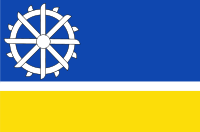
Roda de Ter
Encyclopedia

Osona (comarca)
Osona is a comarca situated in central Catalonia, Spain. Its capital is Vic. Its population is 129,543. Osona covers roughly the same area as the historic Catalan county of Osona. The name Osona comes from Ausetans, a group of Iberian people that had their capital in Ausa ; the Romans called the...
, province of Barcelona
Barcelona
Barcelona is the second largest city in Spain after Madrid, and the capital of Catalonia, with a population of 1,621,537 within its administrative limits on a land area of...
, Catalonia
Catalonia
Catalonia is an autonomous community in northeastern Spain, with the official status of a "nationality" of Spain. Catalonia comprises four provinces: Barcelona, Girona, Lleida, and Tarragona. Its capital and largest city is Barcelona. Catalonia covers an area of 32,114 km² and has an...
, Spain, near Vic
Vic
Vic is the capital of the comarca of Osona, in the Barcelona Province, Catalonia, Spain. Vic's location, only 69 km far from Barcelona and 60 km from Girona, has made it one of the most important towns in central Catalonia.-History:...
, on the Ter River
Ter River
The Ter is a river in Catalonia that rises in Ulldeter at an approximate altitude of 2400 meters, at the foot of a glacial cirque delimited by the nearby peaks of el Bastiments, el Gra de Fajol, or el Pic de la Dona...
above the Sau Reservoir. Population: 5,435 (2004), area: 2.18 km². Its church is dedicated to St. Peter. Main monuments: Pont Vell ("Old Bridge") and the Capella del Sòl del Pont (Chapel of Sun of the Bridge). The Virgin Mary, La Mare de Déu del Sòl del Pont is the patron of the village.
On the site of an Iberian town a Roman villa was established. In its later fortified state it existed until 826
826
Year 826 was a common year starting on Monday of the Julian calendar.- Religion :* June 24 – The Danish king Harald Klak accepts Christianity.- Deaths :...
, when was destroyed by Aissó
Aissó
Ayxun ibn Sulayman ibn Yaqdhan al-Arabí better known as Ayxun or Aissó was an Islamic or a Goth nobleman who led a revolt in Barcelona, Ausona, and Girona in 826 to 827....
, in revolt against the Frankish count Bernat of Septimania
Bernat of Septimania
Bernard of Septimania , son of William of Gellone, was the Frankish Duke of Septimania and Count of Barcelona from 826 to 832 and again from 835 to his execution. He was also count of Carcassonne from 837. He was appointed to succeed his fellow Frank Rampon...
. Many years passed before it was repopulated and grew slowly. The fierce independence of the mountain people of northern Catalonia manifested itself in banditry in which villagers were encouraged to participate, even by their silence, by a share in the takings. The bandit leaders might be peasants or local noblemen. On one occasion in 1646, the whole of the village of Roda de Ter was briefly incarcerated as fautors ("abettors") for their part in sheltering members of a local gang http://web.archive.org/web/20060210035203/http://www.barcelonaconnection.net/docs/bandits.html.
The Catalan fighters against the French forces of the Bourbon Philip V of Spain
Philip V of Spain
Philip V was King of Spain from 15 November 1700 to 15 January 1724, when he abdicated in favor of his son Louis, and from 6 September 1724, when he assumed the throne again upon his son's death, to his death.Before his reign, Philip occupied an exalted place in the royal family of France as a...
are an easily-overlooked local part of the European War of the Spanish Succession
War of the Spanish Succession
The War of the Spanish Succession was fought among several European powers, including a divided Spain, over the possible unification of the Kingdoms of Spain and France under one Bourbon monarch. As France and Spain were among the most powerful states of Europe, such a unification would have...
, but Roda was a hotbed of partisans for the unsuccessful Habsburg claimant. One of them, Francesc Macià i Ambert (died 1713), who came from Roda de Ter, is memorialized in Barcelona by a street and a metro station that bear his nom de guerre Bac de Roda.
Before the comarca was called simply Roda; it took the name of Roda de Ter in late 20th century when the municipality was split into Roda de Ter (the town) and Masies de Roda
Masies de Roda
Les Masies de Roda is a municipality in the province of Barcelona, Catalonia, Spain. It is situated near the Ter River. It has an estimated population of 710, and an area of some 16.5 km²....
(the rural zone). Roda de Ter lies on Catalonian route C-153.
The foundry Fundiciones de Roda produced fine cast iron components for hydraulics.
The Catalan poet Miquel Martí i Pol
Miquel Martí i Pol
Miquel Martí i Pol was one of the most popular poets in Catalan in the 20th century.Martí i Pol was of humble origin and had to quit studying at 14 years, to start working at a factory. Nevertheless, he started publishing poetry in 1954. In 1970 he was diagnosed with multiple sclerosis...
was born in Roda de Ter, March 19, 1929.

